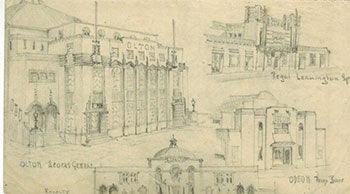
Original drawings of Cinemas in England in the 1930s: Olton, Acocks Green; Regal, Leamington Spa; Odeon, Perry Barr, Birmingham; The Royalty, Bowness-on-Windermere.
Colwyn Bay, Wales. : Circa 1931-1935. Original pencil drawing. 18.5 x 10.8 cm. 4 small drawings on sheet.....
This was the first cinema in the United Kingdom to be called Odeon and was managed/operated by Oscar Deutsch who later founded his Odeon Theatres Ltd. chain in 1933.
Located in the Perry Barr district in the north of Birmingham. The Odeon Theatre, Perry Barr opened on 4th August 1930 with Charles ‘Buddy’ Rogers in “Illusion” and Stewart Rome in “Dark Red Roses”. It was designed by architects Stanley A. Griffiths and Horace G. Bradley in a Moorish style both externally and internally. The facade was painted white and had rounded features that gave an impression of domes. Inside the auditorium seating was arranged for 1,160 in the stalls and 478 in the balcony. An unusual feature was that the stalls area widened out towards the proscenium. There were Moorish scenes painted on the side walls in the front stalls area. The Odeon became part of the Odeon circuit from 17th July 1935......
Located in Olton, Solihull, Warwickshire, to the south-east Birmingham. The Olton Cinema was on the corner of Warwick Road and Brookvale Road. It opened on 2nd October 1933 with Jack Hulbert in “Falling For You”. Seating was provided in stalls and circle levels. The Olton Cinema was independently operated.
The Olton Cinema was closed on 16th September 1972 with Samantha Eggar & Oliver Reed in “The Lady in the Car with Glasses and a Gun”. It was demolished and an office block name Virginia House was built on the site. ....It started out as the Public Hall in March 1927 and screened its first film at the opening ceremony. The hall was also equipped with a stage and dressing rooms, and the flat stalls floor had removable seats and a maple dance floor for conversion to a ballroom. However, film was the staple fare. There were just over 600 seats in the stalls and balcony....
The Royalty:
Extremely long leaseholders, giving some indication of its success throughout the years, have most unusually been a feature of this cinema. From 1930 (when it was renamed Royalty) to 1952 (when he died) Leonard Clegg held the lease. Next Ronald Cowpe retired after his period from 1952 to 1974. The next leaseholder, John Bailey, also died in 1991 after 17 years in control and for a while, the local council controlled the cinema to prevent it from closing until Charles Morris took over in 1992, and long may he continue! Item #51-4729
Price: $250.00
